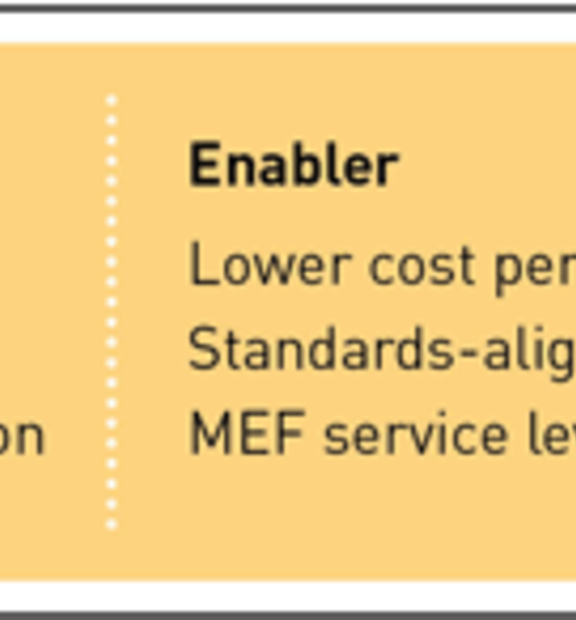By Christopher Cullan, Product Marketing Manager, Business Services Solutions, Infovista
An important question for product managers of communications service providers (CSPs) in today's crowded market is “How can I build differentiated services to retain my existing customers and increase revenues?” Standing out from the crowd is essential for success in any competitive market and is definitely a requirement for CSPs.
CSPs find themselves in what TM Forum calls a “revenue crunch.” Facing exploding growth in traffic–including bandwidth hungry enterprises, virtualized data centers, video and telepresence services, residential broadband, and mobile backhaul–CSPs have been forced to make significant investments in infrastructure to handle the increasing network bandwidth demands. But the revenue received for these services is decreasing and, as a result, CSPs are facing downward pressure on margins.
To survive–and to thrive–in this market environment will require creative product managers to design and deploy services that move up the value chain within their Enterprise customer base. Providing innovative, next-generation services that add additional value to pure transport services is the common solution. Such a solution is enhanced with Carrier Ethernet-based services, as they offer CSPs a promising opportunity to deliver these services at reduced cost as well as enable sources of new revenue. CSPs around the world are taking this approach, as evidenced by the significant Carrier Ethernet equipment investments in recent months.
CSP product managers have three key methods of differentiating from the competition with Carrier Ethernet services–and each requires a specific enabler. They are:
Strong and service-aligned performance management plays a critical role within each enabler to provide the product manager the ability to leverage all methods of differentiation. Let's take a look at each:
Price. Holding down operating expenses is a must if product managers hope to have any flexibility in pricing their Carrier Ethernet-based market offerings and maintain their margins. Effective performance management that can be leveraged throughout the CSP (e.g. IT, Engineering, Operations) and its Enterprise customers is essential to achieving the operational excellence that will drive reduced costs.
Having tools that empower technicians to quickly identify and address problems before they impact customers, and provide engineers with configurable and behavior-based performance events that allow them to identify true network problems easily, will lead to improved operating efficiencies and reduced SLA compliance issues and penalties. Granular, on-demand data collection for in-depth analysis of an identified performance issue is a crucial element of proactive performance management. The ability to capture the service context, measure end-to-end visibility, and quickly alert support staff of performance issues will help the CSP to reduce OPEX, exceed SLA expectations, protect margins, and build pricing power. This operational excellence will also strengthen negotiating positions for future contract extensions.
Performance. The customer's quality of experience (QoE) is the defining factor in the value of a service offering. Product managers cannot hope to achieve a high QoE without meaningful metrics that are easily and regularly monitored to measure the performance of the service across the network and ensure that the perceived value of the service remains high. Performance management that supports the collection, processing, storage, and reporting of infrastructure health, traffic usage, and end-to-end service metrics is essential to delivering and reporting on the exceptional performance that will retain customers and grow market share.
Service offering definition. The Metro Ethernet Forum (MEF) has standardized service types and attributes that make it possible for product managers to define various services targeted to the needs of specific business verticals. For example, they might offer an extreme low-latency service for financial institutions to handle their transactions, an on-demand distributed video service for covering a major sporting event where frame delay variance has strict requirements, or a fault prevention service in electrical transmissions to prevent damage to million-dollar transformer equipment.
Differentiating from the competition with service offering definitions has the greatest potential to positively impact the CSP's top line revenue. To add to this strategy, the service offering can be combined with a highly configurable customer dashboard to improve understanding and reporting on multiple aspects of service performance. Having a performance management solution that leverages Carrier Ethernet standards and allows for vendor-agnostic integration will be essential to achieving rapid time to market for these services. The right performance management solution will enable the quick and efficient deployment of services–despite the complexities of the underlying multi-vendor network–that will capture customers and accelerate growth.
The market for Carrier Ethernet services is proving to be the CSP's salvation in the current environment of revenue and margin pressure. And for the reasons discussed above, robust performance management is a must-have for a product manager's portfolio to best use all three methods of differentiation, keep costs down, deliver on SLAs, and capture and retain valuable customers with exceptional quality of experience.
If you'd like to learn more about this topic, we invite you to download our White Paper–Accelerating Revenue through Carrier Ethernet Service Differentiation











